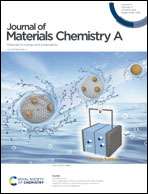The crystal structure and electrical/thermal transport properties of Li1−xSn2+xP2 and its performance as a Li-ion battery anode material†
Abstract
A new ternary layered pnictide, Li1−xSn2+xP2, was synthesized by a solid-state reaction and its properties were examined to explore its potential as a multifunctional material. The compound crystallizes in a layered structure in the R![[3 with combining macron]](https://www.rsc.org/images/entities/char_0033_0304.gif) m space group (no. 166) with buckled honeycomb Sn–P layers separated by mixed-occupation Li/Sn layers. Crystal structure analysis by synchrotron X-ray diffraction showed that the substitution degree of Li by Sn is x = 0.38. The local ordering of Li/Sn occupation was demonstrated using 31P nuclear magnetic resonance analysis. The thermal and electrical transport properties are significantly affected by this local ordering. The lattice thermal conductivity of Li1−xSn2+xP2 was found to be relatively low (1.2 W m−1 K−1 at 525 K). The room-temperature electrical resistivity of Li1−xSn2+xP2 was found to be 0.3–0.4 mΩ cm and metallic conductivity was observed down to 0.5 K. First-principles calculations demonstrated that the electronic structure and Fermi energy of Li1−xSn2+xP2 are significantly dependent upon x. Moreover, the electronic structure of Li1−xSn2+xP2 is different from that of the related compound NaSn2As2, which shows a superconducting transition. Electrochemical measurements using a single-particle technique demonstrated the activity of Li1−xSn2+xP2 as an anode material for rechargeable Li-ion batteries.
m space group (no. 166) with buckled honeycomb Sn–P layers separated by mixed-occupation Li/Sn layers. Crystal structure analysis by synchrotron X-ray diffraction showed that the substitution degree of Li by Sn is x = 0.38. The local ordering of Li/Sn occupation was demonstrated using 31P nuclear magnetic resonance analysis. The thermal and electrical transport properties are significantly affected by this local ordering. The lattice thermal conductivity of Li1−xSn2+xP2 was found to be relatively low (1.2 W m−1 K−1 at 525 K). The room-temperature electrical resistivity of Li1−xSn2+xP2 was found to be 0.3–0.4 mΩ cm and metallic conductivity was observed down to 0.5 K. First-principles calculations demonstrated that the electronic structure and Fermi energy of Li1−xSn2+xP2 are significantly dependent upon x. Moreover, the electronic structure of Li1−xSn2+xP2 is different from that of the related compound NaSn2As2, which shows a superconducting transition. Electrochemical measurements using a single-particle technique demonstrated the activity of Li1−xSn2+xP2 as an anode material for rechargeable Li-ion batteries.



 Please wait while we load your content...
Please wait while we load your content...